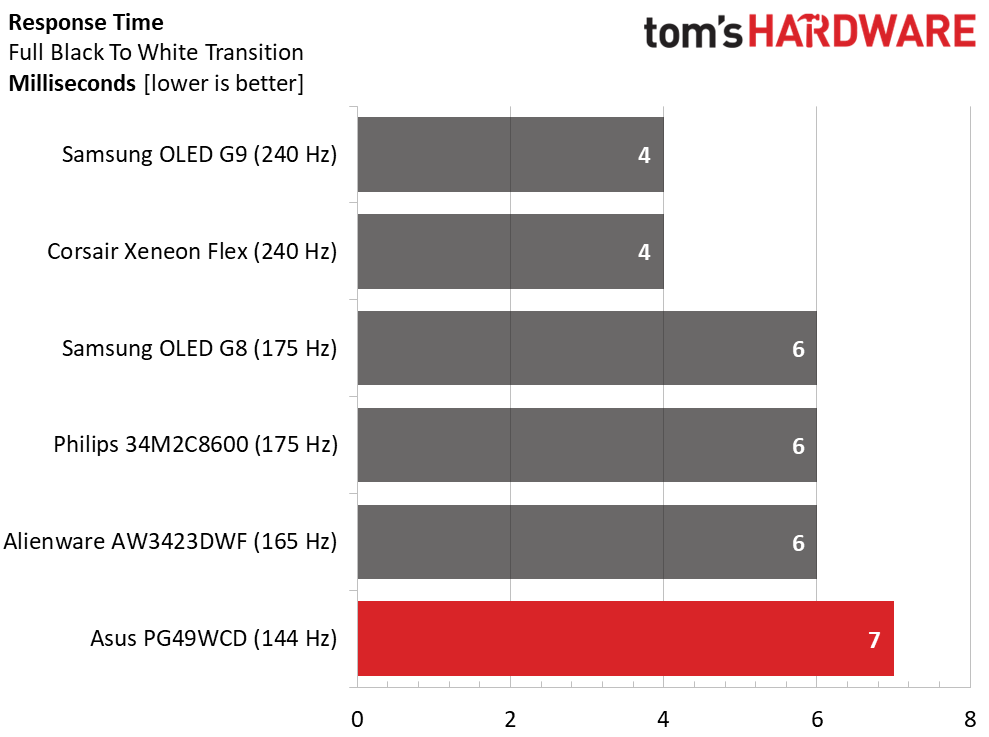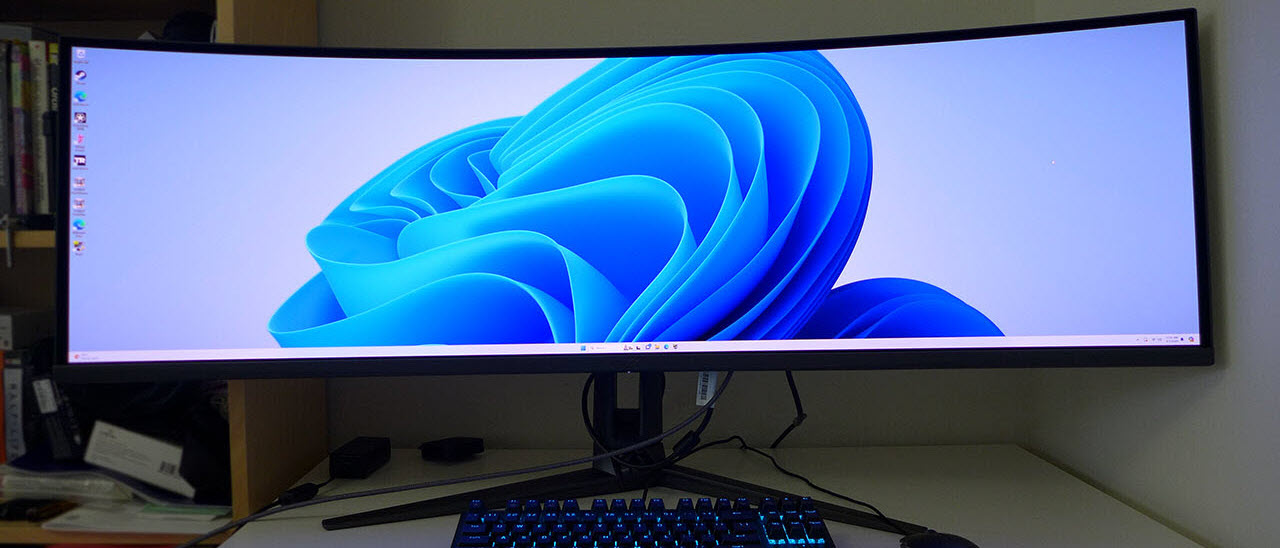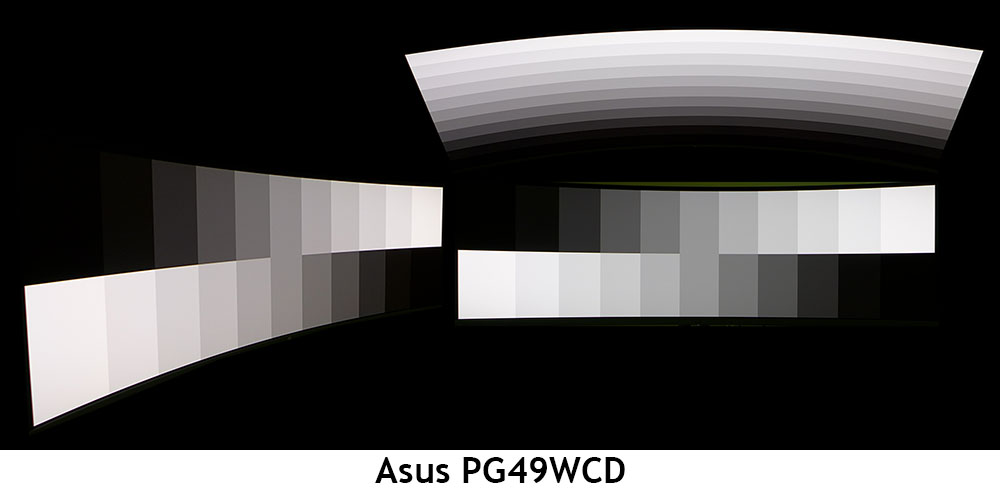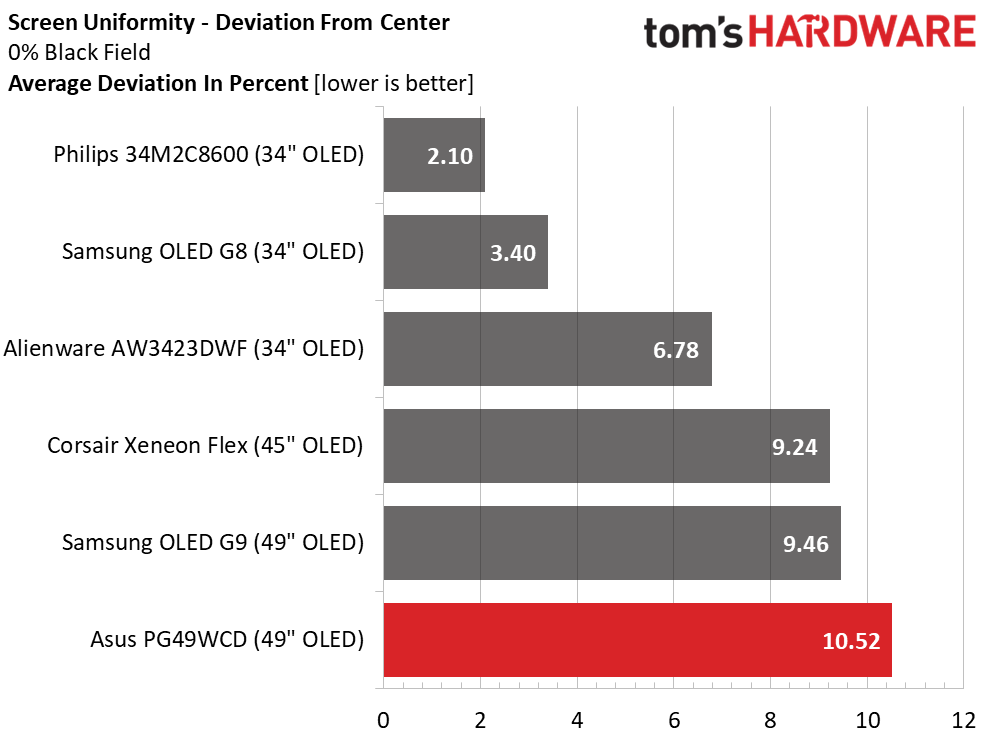Why you can trust Tom's Hardware
There are many ultra- and mega-wide OLED screens available, ranging from 34-inch 21:9 to 49-inch 32:9, like the PG49WCD. For this review, I’ve included Samsung’s OLED G9 and G8, Corsair’s Xeneon Flex, Philips’ 34M2C8600, and Alienware’s AW3423DWF.
Pixel Response and Input Lag
Click here to read up on our pixel response and input lag testing procedures.


It’s hard to ignore that the PG49WCD is 144 Hz while the others are 165, 175 and 240. While OLEDs provide smoother motion than an LCD at a given rate, the PG49WCD is a tad softer than the others. Frame rates do matter. WithItd, it will be smoother than an LCD running at 144 Hz. Looking at Blur Busters patterns, the moving UFOs are slightly short of perfectly rendered.
In the lag test, the PG49WCD also gives quarter to the faster screens. 31ms is still plenty quick for casual players and I never felt like it couldn’t keep up. Better gamers may feel differently and will want to opt for a 240 Hz monitor.
Test Takeaway: I have yet to meet an OLED I didn’t like for gaming. Though the PG49WCD is a tad slower than other ultra and mega-wide screens, it is still better than any LCD running below 360 Hz. Input lag isn’t life-changing, but it is low enough to provide gaming free of perceptible delay. I found it every bit as addictive as every other OLED monitor I’ve gamed on.
Viewing Angles
If you’re shopping for a 49-inch 32:9 monitor, the PG49WCD provides ample justification for paying the OLED premium. The viewing sweet spot is large enough that there is no wrong place to sit. You’ll see the same brightness and color no matter where you look. There is no change in brightness at 45 degrees horizontal and color shifts barely to warmer tones. The top view maintains its gamma and has no appreciable color change. This is as good as it gets.
Screen Uniformity
To learn how we measure screen uniformity, click here.
Get Tom's Hardware's best news and in-depth reviews, straight to your inbox.
OLEDs usually perform well in my uniformity test, and the PG49WCD, though a tad over the 10% line, is no exception. I could not see any issues when viewing a 10% gray field in a dark room. Black patterns shut off all pixels, so there is no way to measure uniformity. This is a premium monitor and, as such, has received premium quality control.
MORE: Best Gaming Monitors
MORE: How We Test PC Monitors
MORE: How to Choose the Best HDR Monitor
Current page: Response, Input Lag, Viewing Angles and Uniformity
Prev Page Features and Specifications Next Page Brightness and Contrast
Christian Eberle is a Contributing Editor for Tom's Hardware US. He's a veteran reviewer of A/V equipment, specializing in monitors. Christian began his obsession with tech when he built his first PC in 1991, a 286 running DOS 3.0 at a blazing 12MHz. In 2006, he undertook training from the Imaging Science Foundation in video calibration and testing and thus started a passion for precise imaging that persists to this day. He is also a professional musician with a degree from the New England Conservatory as a classical bassoonist which he used to good effect as a performer with the West Point Army Band from 1987 to 2013. He enjoys watching movies and listening to high-end audio in his custom-built home theater and can be seen riding trails near his home on a race-ready ICE VTX recumbent trike. Christian enjoys the endless summer in Florida where he lives with his wife and Chihuahua and plays with orchestras around the state.
-
edzieba For OLED panels (or LCD panels with backlight modulation) it'd probably be better to chart grey contrast rather than black contrast - the ratio between the maximum and minimum possible nonzero illumination level. Black contrast with a panel that can turn off a pixel/zone for 0-level will always end up with a divide-by-zero issue and a completely worthless chart. Grey contract (full brightness over minimum displayable brightness) actually gives you a useful measure of real world contrast.Reply
e.g. a screen that can produce 0 nits at 0 input level, 1 nit at an input level of 1, and 1000 nits at an input level of 255, will have much higher perceptual contrast than a screen that will also produce 0 nits at 0 input level, but produces 50 nits at an input level of 1 and 1500 nits at an input level of 255.
The naïve max-brightness-over-zero-level charts are about as helpful as the old 'dynamic contrast' measures manufacturers liked to slap on monitors with backlight modulation (where a TN panel could magically produce a 80,000:1 contrast ratio). -
brandonjclark How would you compare this monitor on "versus" comparison, buy this or that, to the Dell Alienware AW3225QF, readers?Reply -
oofdragon Why these companies keep wasting time and resource launching these huge things not up to date with tech? 144hz is like 10 years ago literally, the minimum now is 240hz or gtfoReply -
subspruce Reply
also this monitor needs 2 people for transport, getting a friend (if you haven't already) or a partner will be a great move if you ever want to move house.oofdragon said:Why these companies keep wasting time and resource launching these huge things not up to date with tech? 144hz is like 10 years ago literally, the minimum now is 240hz or gtfo


